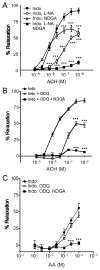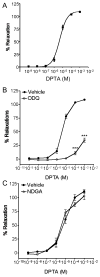Endothelial nitric oxide and 15-lipoxygenase-1 metabolites independently mediate relaxation of the rabbit aorta
- PMID: 22197897
- PMCID: PMC3268834
- DOI: 10.1016/j.vph.2011.12.002
Endothelial nitric oxide and 15-lipoxygenase-1 metabolites independently mediate relaxation of the rabbit aorta
Abstract
Endothelial 15-lipoxygenase-1 (15-LO-1) metabolites of arachidonic acid (AA), 11,12,15-trihydroxyeicosatrienoic acid (THETA) and 15-hydroxy-11,12-epoxyeicosatrienoic acid (HEETA) and nitric oxide (NO) mediate relaxations to acetylcholine (ACH). However, interactions between NO and the 15-LO-1 pathway have not been explored. Therefore, the effect of physiological and pharmacological concentrations of NO on 15-LO activity and relaxation was studied in rabbit aorta. In indomethacin-treated aortic rings, maximal ACH relaxations of 91.3±4.0%, decreased to 54.5±3.0% by the NO synthase inhibitor, nitro-l-arginine (LNA), to 49.8±3% by the guanylate cyclase (GC) inhibitor, 1H-[1,2,4]oxadiazolo[4,3-a]quinoxalin-1-one, to 63.7±4.9% by the lipoxygenase (LO) inhibitor, nordihydroguaiaretic acid (NDGA) and were completely inhibited by the combination of LNA and NDGA. AA relaxations were not affected by GC inhibition but were reduced by LO inhibition. The NO donor, dipropylenetriamine-NONOate (DPTA) caused concentration-related relaxations (EC(50)=4.7×10(-6)M). Aortic metabolism of (14)C-AA to THETA and HEETA was not altered by EC(50) concentrations of DPTA but were reduced 10-fold by 10(-3)M DPTA. In LNA-treated aorta, DPTA (3×10(-6)M) caused relaxations of 38.2.5±4%. Maximum relaxations to ACH did not differ in the presence and absence 3×10(-6)M DPTA (49.5±5% and 44.2±4%, respectively). These results indicate that NO and 15-LO-1 act in parallel to mediate ACH relaxations and NO does not alter 15-LO-1 activity.
Copyright © 2011 Elsevier Inc. All rights reserved.
Conflict of interest statement
The authors of this manuscript have no conflicts of interest to report.
Figures





References
-
- Aggarwal NT, Chawengsub Y, Gauthier KM, Viita H, Yla-Herttuala S, Campbell WB. Endothelial 15-lipoxygenase-1 overexpression increases acetylcholine-induced hypotension and vasorelaxation in rabbits. Hypertension. 2008a;51:246–251. - PubMed
-
- Aggarwal NT, Holmes BB, Cui L, Viita H, Yla-Herttuala S, Campbell WB. Adenoviral expression of 15-lipoxygenase-1 in rabbit aortic endothelium: role in arachidonic acid-induced relaxation. Am J Physiol Heart Circ Physiol. 2007;292:H1033–1041. - PubMed
-
- Aggarwal NT, Pfister SL, Campbell WB. Hypercholesterolemia enhances 15-lipoxygenase-mediated vasorelaxation and acetylcholine-induced hypotension. Arterioscler Thromb Vasc Biol. 2008c;28:2209–2215. - PubMed
-
- Bauersachs J, Popp R, Hecker M, Sauer E, Fleming I, Busse R. Nitric oxide attenuates the release of endothelium-derived hyperpolarizing factor. Circulation. 1996;94:3341–3347. - PubMed
Publication types
MeSH terms
Substances
Grants and funding
LinkOut - more resources
Full Text Sources
Miscellaneous

